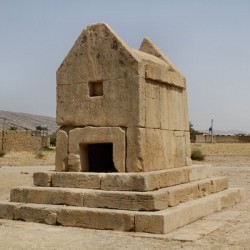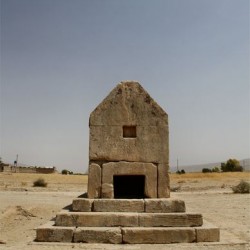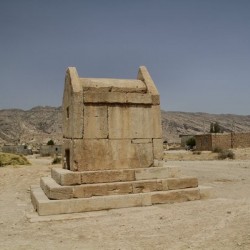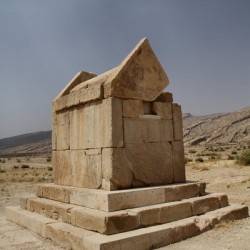Gur-e Dokhtar
Q5950666Gur-e Dokhtar: Achaemenid tomb near Buzpar in western Fars.
Gur-e Dokhtar (Farsi for "the tomb of the virgin"), is the local name of an Achaemenid cut-stone tomb, located in the valley of Buzpar (local phonetic: "Poshtpar"), in the vicinity of Sar-Mashhad, close to the western border of the province of Fars, Iran.
The tomb's architecture is strikingly similar to the mausoleum of Cyrus the Great (r.559-530) at Pasagadae, although it is, with a height of about four meters, much smaller in size. Unlike Cyrus's tomb, which is constructed on a base of seven steps, the monument of Gur-e Dokhtar lays on three rectangular, stratified plane steps, each of about 35cm high. The steps' surface decreases from the first to the upper one.
Made of cut-stones of varying size, sometimes maintained by iron clamps, the tomb's rectangular chamber is opened by a small, rectangular door on the lower part of its front (North) side. It is covered by a horizontal stone roof on which lay another concave slab, probably used to hold a stone cover, now vanished. At each of the tomb's ends, triangular stone gables complete the building above the front and the back walls. A little niche can be seen on the top of each front and back walls.
 The tomb at Gur-e Dokhtar, seen from the Northwest |
 The tomb at Gur-e Dokhtar, seen from the North |
 The tomb at Gur-e Dokhtar, seen from the West |
 The tomb at Gur-e Dokhtar, seen from the Southwest |
Because after Darius the Great (r.522-486), all Achaemenid kings were buried in rock-cut tombs, and because a similar building has been attributed to Cyrus the Great, it seemed logical to assume that a tomb like this must have been erected prior to the tomb of Cyrus. Therefore, it was assumed to have been built in the seventh century BCE, perhaps for one of this king's ancestors. Later, when the iron clamps were studied, it became clear that this building was erected in the fifth century. There is some speculation that it may have been for prince Cyrus the Younger (424-401 BCE).
The tomb is located near a recent nomad settlement. There are two Sasanian buidings in its close vicinity.
Literature
- Louis Vanden Berghe, "Bospār", in: Encyclopaedia Iranica, vol. IV, fasc. 4, pp. 429-430